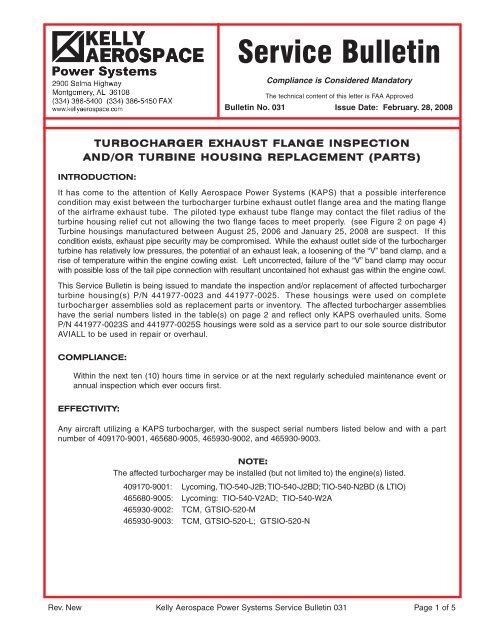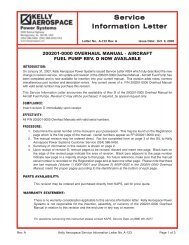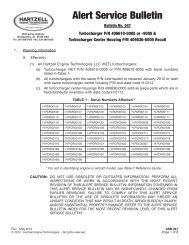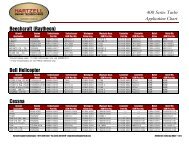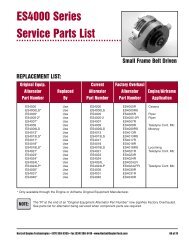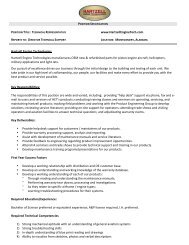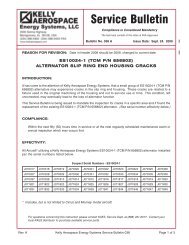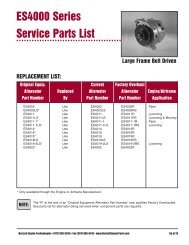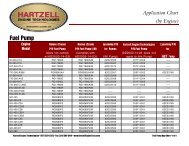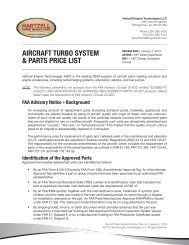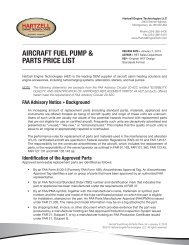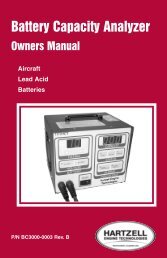Service Bulletin 031 - Hartzell Engine Technologies
Service Bulletin 031 - Hartzell Engine Technologies
Service Bulletin 031 - Hartzell Engine Technologies
You also want an ePaper? Increase the reach of your titles
YUMPU automatically turns print PDFs into web optimized ePapers that Google loves.
TURBOCHARGER EXHAUST FLANGE INSPECTION<br />
AND/OR TURBINE HOUSING REPLACEMENT (PARTS)<br />
INTRODUCTION:<br />
It has come to the attention of Kelly Aerospace Power Systems (KAPS) that a possible interference<br />
condition may exist between the turbocharger turbine exhaust outlet flange area and the mating flange<br />
of the airframe exhaust tube. The piloted type exhaust tube flange may contact the filet radius of the<br />
turbine housing relief cut not allowing the two flange faces to meet properly. (see Figure 2 on page 4)<br />
Turbine housings manufactured between August 25, 2006 and January 25, 2008 are suspect. If this<br />
condition exists, exhaust pipe security may be compromised. While the exhaust outlet side of the turbocharger<br />
turbine has relatively low pressures, the potential of an exhaust leak, a loosening of the “V” band clamp, and a<br />
rise of temperature within the engine cowling exist. Left uncorrected, failure of the “V” band clamp may occur<br />
with possible loss of the tail pipe connection with resultant uncontained hot exhaust gas within the engine cowl.<br />
This <strong>Service</strong> <strong>Bulletin</strong> is being issued to mandate the inspection and/or replacement of affected turbocharger<br />
turbine housing(s) P/N 441977-0023 and 441977-0025. These housings were used on complete<br />
turbocharger assemblies sold as replacement parts or inventory. The affected turbocharger assemblies<br />
have the serial numbers listed in the table(s) on page 2 and reflect only KAPS overhauled units. Some<br />
P/N 441977-0023S and 441977-0025S housings were sold as a service part to our sole source distributor<br />
AVIALL to be used in repair or overhaul.<br />
COMPLIANCE:<br />
Within the next ten (10) hours time in service or at the next regularly scheduled maintenance event or<br />
annual inspection which ever occurs first.<br />
EFFECTIVITY:<br />
<strong>Service</strong> <strong>Bulletin</strong><br />
Compliance is Considered Mandatory<br />
The technical content of this letter is FAA Approved<br />
<strong>Bulletin</strong> No. <strong>031</strong> Issue Date: February. 28, 2008<br />
Any aircraft utilizing a KAPS turbocharger, with the suspect serial numbers listed below and with a part<br />
number of 409170-9001, 465680-9005, 465930-9002, and 465930-9003.<br />
NOTE:<br />
The affected turbocharger may be installed (but not limited to) the engine(s) listed.<br />
409170-9001: Lycoming, TIO-540-J2B; TIO-540-J2BD; TIO-540-N2BD (& LTIO)<br />
465680-9005: Lycoming: TIO-540-V2AD; TIO-540-W2A<br />
465930-9002: TCM, GTSIO-520-M<br />
465930-9003: TCM, GTSIO-520-L; GTSIO-520-N<br />
Rev. New Kelly Aerospace Power Systems <strong>Service</strong> <strong>Bulletin</strong> <strong>031</strong> Page 1 of 5
Suspect Serial Numbers (Turbocharger P/N 465930-9003)<br />
JKR00016 JKR00017 JKR00018 JKR00019 JKR00020 JKR00021 KBR00206 KBR00207<br />
KBR00208 KBR00209 KBR00210 KBR00211 KBR00483 KFR00293<br />
Suspect Serial Numbers (Turbocharger P/N’s 409170-9001, 465680-9005, 465930-9002)<br />
KER00039 KER00040 KER00041 KER00042 KER00043 KGR00<strong>031</strong> KGR00032 KGR00033<br />
KGR00034 KGR00035 KGR00036 KGR00037 KGR00038 KGR00039 KGR00040 KGR00041<br />
KGR00042 KGR00043 KGR00133 KGR00134 KGR00135 KGR00189 KGR00190 KGR00191<br />
KGR00192 KGR00193 KGR00194 KGR00195 KGR00196 KGR00197 KGR00198 KGR00199<br />
KGR00200 KGR00201 KGR00202 KGR00203 KGR00204 KGR00205 KGR00206 KGR00218<br />
KHR00181 KHR00182 KHR00183 KHR00184 KHR00185<br />
Any KAPS turbocharger using a P/N 441977-0023S as a repair or overhaul replacement part or which may<br />
be in unused inventory. Turbine housings of this part number were produced October, 2006 marked 1006<br />
underneath the part number. See spare part notes on page 2 and Figure 4 on page 4.<br />
Any KAPS turbocharger using a P/N 441977-0025S as a repair or overhaul replacement part or which may<br />
be in unused inventory.. Turbine housings of this part number were produced October, 2006 marked 1006<br />
underneath the part number. See spare part notes on page 2 and Figure 4 on page 4.<br />
NOTE:<br />
(Spare Part Only)<br />
For the turbine housings sold as spare parts, the possible (but not limited to)<br />
turbocharger/engine combination may be as listed. These turbocharger<br />
assemblies may have data tags from sources other than KAPS.<br />
409170-0001: Lycoming, TIO-540-J2B; TIO-540-J2BD; TIO-540-N2BD (& LTIO)<br />
465680-0004: TCM, TSIO-520-AF; TSIO-520-P<br />
465680-0005: Lycoming: TIO-540-V2AD; TIO-540-W2A<br />
465930-0002: TCM, GTSIO-520-M<br />
465930-0003: TCM, GTSIO-520-L; GTSIO-520-N<br />
465448-0004: TCM, TSIO-520-CE<br />
466412-0003 : TCM, TSIOL-550-A; TSIOL-550-C<br />
466412-0004: RAM modified engines<br />
NOTE:<br />
(Spare Part Only)<br />
Identification of the affected P/N 441977-0023S and 441977-0025S turbine housings<br />
sold as spare parts may be accomplished by observing the code markings on<br />
the inlet flange mating surface of the housing. See Figure 4 on page 4.<br />
Page 2 of 5 Kelly Aerospace Power Systems <strong>Service</strong> <strong>Bulletin</strong> <strong>031</strong> Rev. New
PROCEDURE:<br />
CAUTION:<br />
This procedure must be performed by competent and qualified personnel familiar with<br />
engine and airframe maintenance activities that are specific to turbocharged aircraft.<br />
CAUTION:<br />
Do not depend on this <strong>Service</strong> <strong>Bulletin</strong> for gaining access to the aircraft or<br />
engine. This will require that you use the applicable manufacturers maintenance<br />
manuals or service instructions. In addition, any preflight or in flight operational<br />
checks require use of the appropriate AFM or POH.<br />
INSPECTION:<br />
NOTE:<br />
If the turbocharger installed on the engine(s) can be positively identified as not<br />
being affected by this service bulletin using the aircraft log books or other certified<br />
aircraft paperwork, no further action is necessary. If it cannot be established<br />
positively, then inspection of the data tag will be required.<br />
NOTE:<br />
(Spare Part Only)<br />
If the turbocharger installed on the engine(s) has been repaired or overhauled<br />
between October 2006 and January 25, 2008 and included the replacement of the<br />
turbine housing P/N 441977-0023S or 441977-0025S, proceed with instructions<br />
starting with step 3. See spare part notes on page 2.<br />
1. Access the aircraft turbocharger by removing the cowling as required in accordance with the instructions<br />
contained in the applicable aircraft maintenance manual.<br />
2. Identify the affected turbocharger by checking data tag for part number and serial number and comparing<br />
to the suspect serial number table on page 2. If the turbocharger is affected continue with these instructions,<br />
if not, proceed to the “Return to <strong>Service</strong>” section step 3 and 4. For spare parts only, see note above.<br />
3. Carefully remove the “V” band clamp from around the turbocharger turbine housing at the turbocharger<br />
exhaust outlet taking care not to move the exhaust tube and tail pipe assembly. Figure 1 shows a “V” band<br />
clamp improperly installed, notice gap and clamp riding up on flange.<br />
4. Inspect the turbocharger turbine housing at the flange area captured by the “V” band clamp. Use a feeler<br />
gauge at the split line between the turbine housing flange and the exhaust tube flange all around the<br />
circumference. The maximum gap should not exceed .005 inch at any point. If you suspect or know<br />
that the exhaust tube and tail pipe assembly was moved at any point prior to checking for the gap,<br />
apply pressure towards the turbine housing flange before taking a measurement. Refer to Figure 2<br />
on page 4.<br />
5. If a gap exceeding tolerance is found, the turbocharger and tail pipe assembly should be removed.<br />
To accomplish this, follow the instructions contained in the applicable aircraft, STC holder, or engine<br />
maintenance manual or service information. Inspect and clean flange areas using methods<br />
recommended by the applicable airframe or engine manufacturer. Do not attempt repair of the turbine<br />
housing. Connect the cleaned exhaust tube to the turbocharger and re-inspect per step 4 above. If<br />
the gap still exceeds tolerance, the turbocharger turbine housing (P/N 441977-0023 or 441977-0025)<br />
must be replaced. Proceed to step 6. If gap tolerance is not exceeded, metal stamp an upper case “I”<br />
in accordance with instructions found in step 7 in the area shown in Fig 3 to indicate the instruction was<br />
performed then proceed to step 10.<br />
6. The turbocharger must be sent to a properly certificated part 145 repair station (or foreign equivalent)<br />
experienced in turbocharger repair.<br />
Rev. New Kelly Aerospace Power Systems <strong>Service</strong> <strong>Bulletin</strong> <strong>031</strong> Page 3 of 5
Typical<br />
Turbocharger<br />
Exhaust Tube<br />
Installation<br />
Shown<br />
Figure 1 - “V” band Clamp<br />
Showing Gap<br />
Figure 3 - Turbine Housing<br />
Trouble Area<br />
Figure 2 - Gap Inspection<br />
Area<br />
Figure 4 - Spare Part<br />
Code Marking<br />
7. Once the turbocharger has been repaired, visually inspect for condition and orientation of the turbine<br />
housing then, using a 1/8” metal stamp of an upper case “I”, stamp the turbine housing in the area shown<br />
in Figure 3. Care must be taken not to extend stamp within 1/8” of the mating edge as it may bulge and<br />
distort the mating surface. When stamped, proceed with the installation.<br />
8. Utilizing the applicable aircraft, STC holder and/or engine manufacturers maintenance manuals or<br />
service instructions, re-install the turbocharger assembly.<br />
Page 4 of 5 Kelly Aerospace Power Systems <strong>Service</strong> <strong>Bulletin</strong> <strong>031</strong> Rev. New
NOTE:<br />
If the existing “V” band clamp is to be used, it should be inspected for damage on the<br />
inside of the “V” prior to re-use. If the inside radius of the “V” is flattened or cut it should<br />
not be used. Obtain the clamp part number from the appropriate aircraft or engine parts<br />
catalog.<br />
9. When connecting the exhaust tube and tail pipe assembly to the repaired turbocharger, it is advisable to<br />
re-check the flange fit per step 4 prior to installing the clamp. Carefully, position and install the “V” band<br />
clamp to manufacturer specifications and proceed to “Return to <strong>Service</strong>” below.<br />
10. If gap tolerance was not exceeded and the metal stamp “I” has been applied per step 5, carefully, position<br />
and install the “V” band clamp to manufacturer specifications and proceed to “Return to <strong>Service</strong>” below.<br />
RETURN TO SERVICE:<br />
1. When the turbocharger has been replaced, the aircraft may be prepared for return to service.<br />
2. Refer to Kelly Aerospace Power Systems <strong>Service</strong> <strong>Bulletin</strong> 23 and perform the recommended turbocharger<br />
operational tests. This consists of turbocharger pre-lubrication, ground running tests, and and operational<br />
flight test. Make sure no air, exhaust, or oil leaks are present. <strong>Service</strong> <strong>Bulletin</strong> may be viewed or downloaded<br />
online via www.kellyaerospace.com.<br />
3. Utilizing the applicable aircraft and engine manufacturers maintenance manuals, install the upper and lower<br />
engine cowls removed to gain access.<br />
4. Upon successful completion of this service bulletin per the applicable compliance time listed on page 1, make<br />
an appropriate log book entry that includes the affected turbocharger model and serial number, along with an<br />
appropriate statement of the inspection and/or repair.<br />
MATERIAL REQUIRED:<br />
One (1) or two (2) each, turbocharger turbine housing, part number P/N 441977-0023 or 441977-0025 as<br />
required. All KAPS parts must be obtained through an AVIALL, Inc.. supplier. AVIALL is the sole distributor for<br />
KAPS turbocharger parts NOTE: Other incidental parts may be required during the removal and installation of the<br />
turbocharger. These parts must be obtained per the aircraft or engine manufacturers parts list from the applicable<br />
manufacturer.<br />
DISPOSITION OF STOCK:<br />
Any unused turbocharger which appears on the Suspect Serial Number Table(s) on page 2 in stock may be returned<br />
for repair or replacement. Any unused turbine housing, P/N 441977-0023S or P/N 441977-0025S sold from<br />
October 2006 through January 25, 2008 with code number 1006 which remains in stock. See Figure 4 on page 4.<br />
WARRANTY STATEMENT:<br />
Kelly Aerospace Power Systems will supply warranty consideration for each affected KAPS Turbine Housing (up<br />
to two per aircraft). Additionally, up to one (1) hour labor per engine or two (2) hours labor per aircraft (at 75.00<br />
USD) will be allowed for the inspection and repair required in this service bulletin. Warranty must be filed<br />
through AVIALL Inc. with the affected turbine housing returned. All normal KAPS warranty procedures<br />
apply. No other warranty consideration related to this service publication applies. This publication does not imply<br />
or state any responsibility for the workmanship of any person or entity performing work or maintenance on the<br />
turbocharger, engine, or aircraft.<br />
CONTACT INFORMATION:<br />
If you have any questions concerning the instructions in this service bulletin, please contact Kelly Aerospace Power<br />
Systems Technical Support at 888-461-6077. Questions concerning aircraft service or operation must be<br />
forwarded to the applicable manufacturer of that product.<br />
Rev. New Kelly Aerospace Power Systems <strong>Service</strong> <strong>Bulletin</strong> <strong>031</strong> Page 5 of 5


